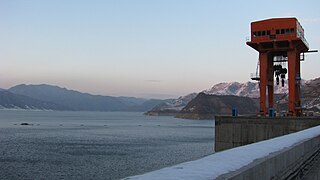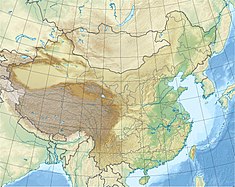
The Laxiwa Dam is an arch dam on the Yellow River in Qinghai Province, northwest China. It is 32 km (20 mi) downstream of the Longyangxia Dam and 73 km (45 mi) upstream from the Lijiaxia Dam. The main purpose of the dam is hydroelectric power generation and it supports the largest station in the Yellow River basin. The facility generates power by utilizing six turbines, each with a generating capacity of 700 MW, totaling to a capacity of 4,200 MW.

Atasu Dam is a concrete-face rock-fill dam on the Gaylan River, 16 km (10 mi) south of Trabzon in Trabzon Province, Turkey. It was built between 1998 and 2010 for the primary purpose of drinking water supply but also has a 5 MW hydroelectric power station.

The Yele Dam is an embankment dam on the Nanya River along the border of Mianning County and Shimian County, Sichuan Province, China. It is 124.5 metres (408 ft) high and 411 metres (1,348 ft) long. Because the dam lies within a Level VIII earthquake intensity zone, its core is composed of asphalt concrete. Construction on the dam began in 2000, the reservoir began impounding on January 1, 2005 and the entire project was complete in August 2006. The purpose of the dam is to produce hydroelectricity and it supports a 240 MW power station. Water from the dam's reservoir is diverted into a 7.2 kilometres (4 mi) long headrace tunnel before reaching the power station.

The Shuikou Dam is a concrete gravity dam on the Minjiang River in Fujian Province, China. The primary purpose of the dam is hydroelectric power generation and it supports a 1,400 MW power station with 7 x 200 MW Kaplan turbines. The dam also provides navigation with a 500-ton ship lock and lift. Other purposes include flood control, irrigation and recreation.

The Longyangxia Dam is a concrete arch-gravity dam at the entrance of the Longyangxia canyon on the Yellow River in Gonghe County, Qinghai Province, China. The dam is 178 metres (584 ft) tall and was built for the purposes of hydroelectric power generation, irrigation, ice control and flood control. The dam supports a 1,280 MW power station with 4 x 320 MW generators that can operate at a maximum capacity of 1400 MW. Controlling ice, the dam controls downstream releases to reservoirs lower in the river, allowing them to generate more power instead of mitigating ice. Water in the dam's 24.7 billion m3 reservoir provides irrigation water for up to 1,000,000 hectares of land.

The Hongjiadu Dam is a concrete face rock-fill embankment dam on the Liuchong River in Qianxi County, Guizhou Province, China. The dam is 179.5 metres (589 ft) tall and was built for the purposes of hydroelectric power generation and water supply. The dam supports a 600 MW and withholds a 4,947,000,000 cubic metres (4,010,598 acre⋅ft) reservoir.

The Dachaoshan Dam is a gravity dam on the Lancang (Mekong) River in Yunnan Province, China. The sole purpose of the dam is hydroelectric power production as it supplies water to a power station containing six 225 MW generators for a total installed capacity of 1,350 MW.

The Jinghong Dam is a gravity dam composed of roller-compacted concrete on the Lancang (Mekong) River near Jinghong in Yunnan Province, China. The main purpose of the dam is hydroelectric power production and it has an associated 1,750 MW power station. Part of the power generated is sold to Thailand under an agreement with China.

The Guanyinyan Dam is a gravity dam on the Jinsha River 30 km (19 mi) southwest of Panzhihua on the border of Yunnan and Sichuan Provinces in China. The purpose of the dam is hydroelectric power generation and flood control. Construction on the dam started in 2008 and the river was diverted by 2010. The first generator was operational on 20 December 2014 and the fourth on 14 December 2015. The entire power station should be operational by 2016. When complete, the dam will support a 3,000 MW power station consisting of five 600 MW Francis turbine generators.

The Jishixia Dam is a concrete face rock-fill embankment dam on the Yellow River in Qinghai Province, China. It is 101 m (331 ft) tall and downstream from the Gongboxia Dam. The purpose of the dam is hydroelectric power generation and flood control. The dam supports a power station with 3 x 340 MW Francis turbines for a total installed capacity of 1,020 MW. Construction on the dam began in 2005 and the river was diverted in March 2007. The first generator was operational in mid-2010 and the rest by the end of the year.

The Okutadami Dam (奥只見ダム) is a concrete gravity dam on the Tadami River, 26 km (16 mi) east of Uonuma on the border of Niigata and Fukushima Prefectures, Japan. The primary purpose of the dam is hydroelectric power generation and it supports a 560 MW power station which is the largest conventional hydroelectric power station in Japan. The dam also forms the second largest reservoir in Japan, next to that of the Tokuyama Dam.

The Jilintai I Dam is a concrete-face rock-fill embankment dam on the Kash River, 29 km (18 mi) east of Nilka in Xinjiang, China. The dam was constructed between 2001 and 2005 for several purposes but mainly hydroelectric power generation. It supports a 460 MW power station. The Jilintai I is the first of 10 dam projects on the Kash. Construction of Jilintai II, directly downstream, begin in May 2008 and the 50 MW power station was commissioned in October 2010. The project, including the diversion dam, was complete in April 2011.

The Huanglongtan Dam is a concrete gravity dam located on the Du River, a tributary of the Han River. It is located 25 km (16 mi) west of Shiyan in Hubei Province, China. The main purpose of the dam is hydroelectric power generation but it also provides for flood control. It was constructed between 1969 and 1976 and support a 510 MW power station.

The Malutang Dam is a concrete-face rock-fill dam (CFRD) on the Panlong River in Malipo County, Yunnan Province, China. The primary purpose of the dam is hydroelectric power generation and the power plant was constructed in two stages. Stage I consists of a 40 m (131 ft) tall gravity dam which diverted water through a 3,460 m (11,352 ft) long tunnel to a 100 MW above ground power station downstream. Construction on Stage I began in 2002 and the first of 50 MW Francis turbine-generators was commissioned in October 2004, the second in January 2005. Stage II was the construction of a 156 m (512 ft) tall CFRD 200 m (656 ft) downstream of the Stage I dam. Stage II's power station contains three 100 MW Francis turbine generators. Construction on Stage II began in August 2005 and the reservoir began to fill in October 2009. In December 2009, the first 100 MW generator was operational and the last two by May 2010. Malutang Dam's reservoir submerged the Stage I dam but the Stage II intake tower receives water for both stages, allowing Stage I to continue to operate.

The Shiyazi Dam is a concrete gravity dam on the Hongjiadu River, a tributary of the Wu River, in Wuchuan County, Guizhou Province, China. The primary purpose of the dam is hydroelectric power generation. Construction on the dam began in 2007 and concrete pouring in April 2008. The reservoir began to impound in September 2010. The dam was "capped off" with concrete on 24 December 2011 and the generators were commissioned a week later on 31 December. The dam, being located in a steep portion of Meilin Canyon, was difficult to construct. The 134.5 m (441 ft) tall dam withholds a reservoir with a capacity of 321,500,000 m3 (260,644 acre⋅ft) and was constructed with both normal concrete and roller-compacted concrete. The dams power station is located 320 m (1,050 ft) downstream and contains two 70 MW Francis turbine-generators for an installed capacity of 140 MW.

The Suofengying Dam is a concrete gravity dam on the Wu River, 44 km (27 mi) northwest of Guiyang in Guizhou Province, China. It is located 35.5 km (22 mi) downstream of the Dongfeng Dam and 74.9 km (47 mi) upstream of the Wujiangdu Dam. The primary purpose of the dam is hydroelectric power generation and it supports a 600 MW power station. Construction on the dam began on 26 July 2002 and on December 18 of that year, the river was diverted. Pouring of roller-compacted concrete into the dam's body began on 14 January 2004 and in June, the dam began to impound its reservoir. On 18 August, the first generator was operational and the last two in 2005. The 121.8 m (400 ft) tall dam creates a reservoir with a capacity of 201,200,000 m3 (163,115 acre⋅ft). The dam's power station is located on its right bank and contains three 200 MW Francis turbine-generators.

The Unbong Dam, or Yunfeng Dam, is a concrete gravity dam on the Yalu River which borders China and North Korea. It is located 33 km (21 mi) northeast of Ji'an in Jilin Province, China and Chasŏng in Chagang Province, North Korea. The primary purpose of the dam is hydroelectric power generation and it supports a 400 MW power station. Construction of the dam had initially began in August 1942 but was halted in 1945 after the surrender of Japan ending World War II. In October 1959, construction on the dam recommenced and in September 1965, the first of the four 100 MW Francis turbine-generators was operational. The last generator was operational on 4 April 1967. The 113.75 m (373 ft) tall dam creates a reservoir with a storage capacity of 3,895,000,000 m3 (3,157,728 acre⋅ft). The dam's spillway is an overflow type with 21 floodgates and has a maximum discharge of 21,900 m3/s (773,391 cu ft/s). The dam is located before a bend in the river and its power station is located on the other side of a ridge that meets the dam’s right abutment. Water is delivered to the power station via two tunnels, 775 m (2,543 ft) and 759 m (2,490 ft) long. Generators 1 and 3 deliver power to China while 2 and 4 deliver to North Korea.

The Daguangba Dam is a multi-purpose dam on the Changhua River in Hainan Province, China. It is located 35 km (22 mi) east of Dongfang. As the primary component of the Daguangba Multipurpose Project, the dam was constructed between 1990 and 1995. It serves to provide water for both hydroelectric power generation and agriculture. It supports a 240 MW power station and supplies water for the irrigation of 12,700 ha. It is also the largest dam and hydroelectric power station in Hainan.

The Gongguoqiao Dam is a gravity dam on the Lancang (Mekong) River in Yunlong County of Yunnan Province, China. The primary purpose of the dam is hydroelectric power generation. Construction began in 2008 and the river was diverted around the dam site in 2009. The next year concrete placement began and in 2011 the first generator was commissioned. The 900 MW power station was fully operational on 21 June 2012.

The Sinanjiang Dam is a concrete-face rock-fill dam on the Sinan River, a tributary of the Lixian River, in Mojiang Hani Autonomous County of Yunnan Province, China. The primary purpose of the dam is hydroelectric power production and it supports a 201 MW power station. Construction began in October 2003 and the river was diverted around the dam site on 5 February 2005. All three generators were commissioned in 2008. To produce power, water from the reservoir is diverted around a bend in the river through a 10.3 km (6.4 mi) long headrace tunnel which connects to the power station via a penstock. The power station contains three 67 MW Francis turbine-generators.










